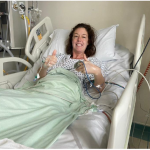Lin from Kent was diagnosed with an Acoustic Neuroma in September 2020. Nearly two years on, Lin shares her story and experiences of life with an Acoustic Neuroma following recent radiosurgery.
The start of my journey
My initial diagnosis in September 2020, age 53, showed a 12mm Acoustic Neuroma which was monitored under active surveillance for 18 months. In March 2022, I was told that the tumour had grown faster than expected to, around 22mm, which meant it was time to have treatment.
grown faster than expected to, around 22mm, which meant it was time to have treatment.
I had a meeting in April with the multi-disciplinary team at Kings College Hospital London where I was advised I could choose between surgery or radiosurgery. I was advised that with surgery, they tend not to be able to remove all of the tumour to preserve the facial nerve functions. Radiosurgery was presented as a less invasive option with the aim of preventing the tumour from growing further. The team advised me that radiosurgery had a 90-95% success rate, which seemed like pretty good odds to me!
Making a decision
When I was first diagnosed, my initial feelings were ‘get it out’! After a lot of reading and talking to others who experienced surgery and radiosurgery, I came to realise there was not a simple ‘cure’ and that I had to come to terms with living with my unwanted guest and the impact it had. I was told that if it was removed, it would not cure the symptoms I was having which include deafness, constant and extremely loud tinnitus, discomfort in the mastoid area and veering to the left!
I was aware that surgery and radiosurgery can bring their own challenges and was concerned that I may experience other symptoms but was reassured by my clinical team. I was worried about the swelling that can occur with radiosurgery, and I had been told originally that due to the location of the tumour I was unlikely to be a candidate for radiotherapy treatment. On speaking to my neuro-oncologist, they confirmed that their treatment preference for me was radiosurgery.
Following this conversation, I decided to go ahead with radiosurgery. This was when I panicked that I had made the wrong choice. With the help of some coaching from Molly at brainstrust, I began to feel happier about my choice. During this time, I was starting to worry about waiting too long for the treatment to start given how quickly my tumour had grown. I spoke to my clinical team, and I was given dates for May to start mask fitting and more scans, with the treatment taking place in June.
Starting radiosurgery
Due to the size and position of my tumour, I was advised that the radiosurgery would be delivered in three sessions at Guys Cancer Centre in London with 19.5 grays of radiation used. Prior to starting my treatment, I had to go for an MRI scan, a CT scan, and a mask fitting. Thankfully I was able to do this all in one day as we were having to travel to London from Whitstable in Kent. It was a very long day and I would advise anyone having to do the same to make sure you take plenty of snacks and water!
I was worried about travelling from my home to the hospital every day whilst I was having the treatment, so we decided to stay at a hotel near the hospital. This, I believe, made a huge difference to how I felt during the treatment. The treatment days were very hot, so I was very grateful for the hotel air conditioning! I imagined I would be done in each day, but actually the treatment itself is so easy. The mask was a bit tight and uncomfortable, so I made sure I took paracetamol on the 2nd and 3rd day and drank lots of water afterwards to avoid headaches.
The team at the hospital were so kind, and my husband was allowed in whilst they were setting up the machines, which are amazing. I was in the room having treatment for about 40 minutes each time, which was longer than I thought, but I used relaxation techniques learnt from the hypnotherapy sessions organised by brainstrust. The procedure itself is totally painless and quite fascinating! I did cry a little each time they let my husband back in the treatment room; just out of relief that it hadn’t been that bad at all! My husband and I ended up having the nicest three days in London, drinking Pimm’s by the river, eating out, seeing the amazing ‘Superbloom’ display at the Tower of London gardens…I felt a bit of a fraud!
I was prescribed 20mg of dexamethasone from the start of my treatment for 7 days, which helped avoid swelling but gave me a false sense of my own superhuman powers; I was swimming in the hotel pool at 6am! From days 3-6 of being on the steroids, I really struggled to sleep, but they got me through the treatment, and I was able to really enjoy the time in London. The day after I finished my treatment, my husband caught COVID-19 which was a worry as steroids compromise your ability to fight illness. Thankfully I didn’t catch it as I was already banished to the spare room as I was up all night reading and watching movies! I experienced a bit of nausea, but it certainly didn’t stop me from eating!
Life after radiosurgery
Two weeks after I finished my treatment, I had a call with the hospital and at the time I was on the beach swimming. I wasn’t experiencing any adverse effects at all at that time and felt great! Fast forward 2 months on, I have had only minor side effects so far. I am certain that is because I have adjusted my life to let myself heal from what is in effect brain surgery but without the scar! I make sure I rest in the afternoon, have taken time out of working and looking after my little granddaughter and I make sure that I plan my days so that if I have a party or an event to go to, I will not have anything on the next day.
I have experienced some heavy pressure type headaches and flashing lights and floaters on the side that I had my treatment; but the extremely hot weather could have contributed to this. I found these symptoms and my balance were often worse if I didn’t have my afternoon nap. I have had some acupuncture sessions, and these have really helped my headaches and my overall wellbeing.
Focusing on really nurturing yourself during this time is crucial to overall healing and wellbeing as we cannot underestimate both the physical effects and psychological effects of knowing we have a brain tumour.
I am in absolute awe of the scientists and engineers who design and make the amazing machines as well as the genius radiographers and consultants who plan and deliver our treatment. I wish I had not worried so much beforehand, it really was okay.
Now it is a waiting game, there can be swelling at the 3-to-6-month mark, and I won’t be scanned again for 18 months as it can look as if it has grown when it hasn’t. I have had to learn to live with the uncertainty and accept my life is different now, but I have made changes I wanted to make anyway and am grateful to be able to. If you are waiting for treatment or lucky enough to be given a choice of treatments my advice would be to find out all you can about the options, know there is support from brainstrust to help you feel okay about what is ahead, remember to breathe and that you are not alone. I shall be at a music festival in Spain next month, so still living my best life. (maybe with some emergency steroids to hand if needed! ).
Lin x









